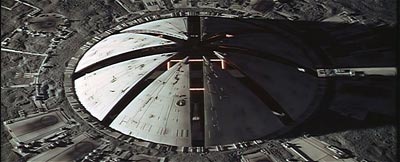Science fiction and science factby Anthony Young
|
| In the world of science fiction there are no limits, and the funds needed to build such colossal structures and spacecraft are apparently unlimited as well. |
But money is most definitely an issue with Project Constellation. In fact, the Congressional Budget Office and the Space Frontier Foundation, among others, have warned that NASA’s plans for launch vehicles and spacecraft, and the overall program, run the risk of quickly outstripping the budget the agency has projected. The CBO issued A Budgetary Analysis of NASA’s New Vision for Space Exploration in 2004 and Alternatives for Future U.S. Space-Launch Capabilities in October of this year. Interestingly, after closely examining the alternatives for launch vehicles using current and upgraded versions of existing launchers and the trades involved, the CBO could not overwhelmingly fault the approach NASA has decided to take, with the exception of questioning the five-segment booster for Ares 1 instead of going with the proven four segment SRB currently used on the shuttle. The Space Frontier Foundation issued a scathing report, “Unaffordable and Unsustainable? Signs of Failure in NASA’s Earth-to-orbit Space Transportation Strategy” issued this past summer, which takes aim at NASA’s underutilization of commercial launch capabilities.
These reports are just a few that have appeared questioning NASA’s approach to the Vision for Space Exploration in general and Project Constellation it particular. It should be noted that much the same occurred throughout the 1960s during Project Apollo. Such governmental and private sector oversight is necessary, but as some have complained, NASA will do what NASA will do.
With regard to the launchers of Project Constellation, it should come as no surprise that NASA would chose launchers that would use as much of the existing Kennedy Space Center infrastructure as possible, including the Vehicle Assembly Building and Launch Complex 39. And when it comes to sending to the Moon the amount of payload to support the mission length and its crewmembers, only a vehicle the size of the Ares 5 can handle it with a single launch, and only the VAB can handle the Ares 5.
NASA recently presented its Global Exploration Strategy and Lunar Architecture at the 2nd Space Exploration Conference in Houston. It unveiled the initial plan of establishing an outpost at a polar location. NASA currently favors locating the outpost near the rim of Shackleton Crater close to the Moon’s south pole. The first mission to land would be only six to seven days in duration with the lunar lander as the habitation module, if you will. The goal is to build up the outpost with habitation modules and infrastructure to eventually permit stays of up to half a year. It cannot realistically be on the scale of Clavius Base. That will have to remain a fiction for many years while the rigors of long duration living on the Moon make themselves known to future Constellation crews. During their rare moments of rest, they might watch 2001 on DVD, and smile.
